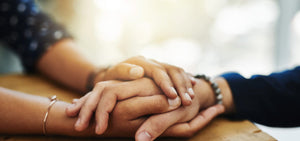10 Natural Things You Can Do for Your Chronic Pain

Our Pain is Insane
With 20% of Australians suffering from chronic pain, and pain being the most common reason someone will visit a healthcare Practitioner in Australia,[1] there is no question that we’re a nation in pain and inflamed!
To understand how to reduce pain, we need to look at its main cause, inflammation, which is triggered in response to tissue injury or infection. The inflammatory process is designed to initiate healing and also to keep you resting while healing occurs. For this reason, the swelling that comes with inflammation stimulates nerves around the affected area, sending signals to your brain that something is wrong by causing you pain, and consequently restricting your movement.
It’s also important to understand that inflammation is a two-phase process. The swelling and pain described above are part of the first phase (the ‘initiation phase’). The second phase (the ‘resolution phase’) begins once the tissue damage or infection has been repaired, and involves clearing away inflammatory cells and any tissue wastes produced during the first phase. The resolution phase ultimately eliminates pain and returns the body to health.
In states of chronic pain, however, the resolution does not occur, and instead, the body becomes stuck in the initiation phase, with persistent inflammation and pain. To reduce chronic pain, then, we need to address both phases of inflammation – initiation and resolution.

Medication is Not Resolution
Once your pain becomes persistent, it’s not uncommon to seek relief from pharmaceutical pain relievers like opioids, analgesics and non-steroidal anti-inflammatories (NSAIDs). Unfortunately, these medications simply block you from feeling pain (e.g. opioids and analgesics), or halt the inflammatory process (e.g. NSAIDs); they do not resolve your inflammation and pain.
In fact, some NSAIDs may actually stop the body from progressing to the resolution phase, because they turn down the production of certain inflammatory chemicals which are necessary for resolution.[2]
Clearly, whilst pain medications are useful for reducing symptoms, resolving the inflammatory process offers more lasting relief.
10 Natural Things You Can Do For Your Chronic Pain
In order to manage ongoing pain, the underlying cause, inflammation, must be addressed and resolved. Natural medicines and certain dietary and lifestyle interventions enable your body to calm and resolve the inflammatory response, while also reducing the nerve irritation that causes pain. This ultimately shifts your body into that healing resolution phase, reducing your reliance on medication and putting you on the road to a pain-free life.
Here are 10 natural ways to reduce your pain:
Natural medicines:
1. Magnesium This mineral helps relieve pain by reducing inflammation, soothing tight muscles in inflamed areas, and also by reducing the firing of pain pathways in the brain. It does this by regulating nerve signalling, muscle contraction [3] and the production of brain chemicals (neurotransmitters) that influence pain perception (the way pain is recognised and interpreted by the brain).[4]
2. Specialised Pro-Resolving Mediators (SPMs) These are lipid (fat-based) compounds that flick the switch from the inflammatory initiation phase to the anti-inflammatory, healing resolution phase, while also reducing pain by altering pain perception. SPMs are normally produced by the body, however, when inflammation and pain become chronic, the capacity for the body to produce SPMs becomes compromised. In these cases, an SPM supplement may help to turn on the resolution phase.
3. Fish oil Omega-3 fatty acids from fish oil regulate the activity of inflammatory cells, minimising the severity of inflammation and pain in the initiation phase of inflammation, without preventing the resolution phase from engaging. Supplementing with fish oil is especially important if you don’t regularly consume omega-3-rich foods (e.g. wild-caught fish), as your body may be lacking in these anti-inflammatory fats.
4. Turmeric A potent anti-inflammatory herb.

5. Devil’s Claw Helping to reduce the reliance on analgesic medications (and the side effects occurring with their prolonged use), devil’s claw carries the capacity to reduce the sensation of pain in the brain,[5] whilst also reducing inflammation[6] – a powerful combination!
Natural diet and lifestyle interventions:
6. Diet The body cannot work to resolve pain if inflammation is being continually initiated by the consumption of inflammatory foods[CM6] such as sugar, refined carbohydrates, vegetable oils, trans fats and preservative-rich processed foods. Instead, swap these for a diet rich in colourful vegetables, fruits, eggs, nuts and seeds, whole grains, legumes and organic meats and seafood. This will provide your body with a bevy of anti-inflammatory and tissue healing nutrients working to put out that painful inflammatory fire.
7. Exercise Whilst chronic pain may have you thinking rest is important and exercise impossible, your body may be craving some movement. A large scientific review examining the use of exercise in chronic pain suggested that exercise “may improve pain severity and physical function, and consequent quality of life”.[7]
8. Sleep Research examining people with fibromyalgia (a condition of chronic musculoskeletal pain) found 90% of subjects experienced a sleep disorder directly correlated with their pain.[8]However, poor sleep quality or quantity then also decreases your pain threshold![9] So, to ensure you get a good night’s sleep, use herbs like the ones discussed here to manage your pain.

9. Stress Did you know that psychological stress can increase your perception of pain?[10] If you’re in pain, but also tend to feel stressed or anxious, read on for a stress management technique that may help to reduce your pain intensity.[11]
10. Meditation Whilst meditating may feel like the last thing you wish to do when in pain, evidence supports its usefulness in improving the psychological complications of living with chronic pain, such as depression[12] and stress. Developing daily mindfulness practise may, therefore, help to improve overall feelings of wellbeing, quality of life and contentedness.
The overall goal when inflamed and in pain is to assist the body in resolving inflammation. Remember, although pain-relieving medications reduce your symptoms, some may actually inhibit inflammation resolution. To reduce and resolve your inflammation, and therefore your pain, try the 10 natural tools above. By addressing inflammation naturally, you can reduce your reliance on medications, increase your quality of life, and finally resolve your pain.
[1] Pain Australia Limited. Painful facts [Internet]. Deakin ACT: Pain Australia Limited [cited 2019 June 19]. Available from: https://www.painaustralia.org.au/about-pain/painful-facts
[2] Sugimoto MA, Sousa LP, Pinho V, Perretti M, Teixeira MM. Resolution of inflammation: what controls its onset?. Front Immunol. 2016 Apr 26;7:160. doi: 10.3389/fimmu.2016.00160.
[3] Rossier P, Van Erven S, Wade DT. The effect of magnesium oral therapy on spasticity in a patient with multiple sclerosis. Eur J Neurol. 2000 Dec;7(6):741-4.
[4] Kirkland A, Sarlo G, Holton K. The role of magnesium in neurological disorders. Nutrients. 2018 Jun 6;10(6):730. doi: 10.3390/nu10060730.
[5] Uchida S, Hirai K, Hatanaka J, et al. Antinociceptive effects of St John’s wort, Harpogophytum procumbens extract and grape seed proanthocyanidins extract in mice. Biol Pharm Bull. 2008;31(2):240-245. PMID: 18239280.
[6] Andersen ML. Evaluation of acute and chronic treatments with Harpogophytum procumbens on Freund’s adjuvant-induced arthritis in rats. J Ethnopharmacol. 2004;91:325-330. doi: 10.1016/j.jep.2004.01.003
[7] Uchida S, Hirai K, Hatanaka J, et al. Antinociceptive effects of St John’s wort, Harpogophytum procumbens extract and grape seed proanthocyanidins extract in mice. Biol Pharm Bull. 2008;31(2):240-245. PMID: 18239280.
[8] Andersen ML. Evaluation of acute and chronic treatments with Harpogophytum procumbens on Freund’s adjuvant-induced arthritis in rats. J Ethnopharmacol. 2004;91:325-330. doi: 10.1016/j.jep.2004.01.003
[9] Geneen LJ, Moore RA, Clarke C, Martin D, Colvin LA, Smith BH. Physical activity and exercise for chronic pain in adults: an overview of Cochrane Reviews. Cochrane Database Syst Rev. 2017 Apr 24;4:CD011279. doi: 10.1002/14651858.CD011279.pub3.
[10] Keskindag B, Karaaziz M. The association between pain and sleep in fibromyalgia. Saudi Med J. 2017 May;38(5):465-475. doi: 10.15537/smj.2017.5.17864.
[11] Keskindag B, Karaaziz M. The association between pain and sleep in fibromyalgia. Saudi Med J. 2017 May;38(5):465-475. doi: 10.15537/smj.2017.5.17864.
[12] Blackburn-Munro G, Blackburn-Munro RE. Chronic pain, chronic stress and depression: coincidence or consequence? J Neuroendocrinol. 2001 Dec;13(12):1009-23. Review. doi: 10.1046/j.0007-1331.2001.00727.x.
[13] Reiner K, Tibi L, Lipsitz JD. Do mindfulness-based interventions reduce pain intensity? A critical review of the literature. Pain Med. 2013 Feb;14(2):230-42. doi: 10.1111/pme.12006.
[14] Ball EF, Nur Shafina Muhammad Sharizan E, Franklin G, Rogozińska E. Does mindfulness meditation improve chronic pain? A systematic review. Curr Opin Obstet Gynecol. 2017 Dec;29(6):359-366. doi: 10.1097/GCO.0000000000000417.
- Kevin Tresize






Comments 0